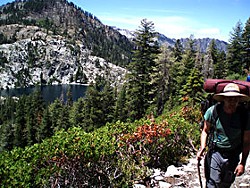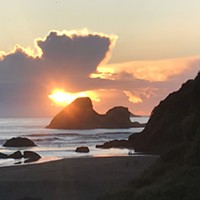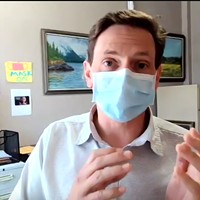The high Alps — Notes from a climb up to Big Caribou Lake
A few hours drive away from the fog and traffic noise of Eureka, hikers and backpackers huff their way up hundreds of feet to escape the trappings of everyday life. They come to explore untouched wilderness with a guarantee to catch spectacular views amon
By Bill Morris and Lucas R. Garcia[
{
"name": "Top Stories Video Pair",
"insertPoint": "7",
"component": "17087298",
"parentWrapperClass": "fdn-ads-inline-content-block",
"requiredCountToDisplay": "1"
}
]
A long, difficult hike in — but well worth the effort. Photo by Bret Bosma.
A few hours drive away from the fog and traffic noise of Eureka, hikers and backpackers huff their way up hundreds of feet to escape the trappings of everyday life. They come to explore untouched wilderness with a guarantee to catch spectacular views amongst the Trinity Alps.
The New Caribou Lakes Trail, which leads to the biggest lake in the Alps, is a moderate 10-mile trek that climbs approximately 1,700 feet in elevation. From Big Flat campground at the end of Coffee Creek Road, the trail rises to campsites surrounding three lakes. For our group of eight amateur hikers — some of whom are smokers — the trail was often brutal, stretching from about 5,200 feet in elevation to 7,200 feet, at the highest point. But the labored breathing is easily forgotten when new vistas appear around every corner and city noises are replaced by the whirring of dragonflies and the wind threading through the trees.
Basking on the granite shores of Big Caribou. Photo by Bret Bosma.
Since there are four different trails leaving Big Flat, finding the New Caribou Lakes Trail may be difficult. Crossing the South Fork Salmon River, however, we picked up the trail. A signpost confirmed we were headed in the right direction and we climbed steep switchbacks for about a mile and a half. The trail gradually ascended toward more hairpin turns taking us over a saddle towards Brown’s Meadow, our anticipated luncheon oasis. By mile three, where Old and New Caribou Trails cross, we had passed through the forest floors. In the days prior to our hike, rain had settled the dust. As we marched past 6,000 feet in elevation, a passing hiker told us that Brown’s Meadow would be the last chance for water until we reached the lakes.
Hiking has little to do with your brand of boots, the food you bring or the fancy pack you just bought. Available water is essential for any hike. Prior to our trip, all precautions were taken to identify potential sources of water: calls to the closest ranger station, studies of drainages on the map and chats with experienced hikers. Coast-dwellers, accustomed to the moist marine layer, may underestimate how much hydration is needed when hiking in the dry air.
Once past Brown’s Meadow, white and black bespeckled granite composes the rest of the well-maintained trail. Granite passes offer few trees and scarce shade. Ascending about half a mile out of the meadow, the trail turns on to the western-facing slope of Caribou Mountain for two miles of sun-soaked trail. Some of us fair-skinned fog-folk were wise enough to slather on sunscreen at lunch. The rest of us were goaded by the sun and enticed by a first glance of lakes. Midday sun saw us soak our shirts, skitter along an ancient glacial chasm and crest the peak of the trail in the tepid air. Some took breaks for breathtaking views, others took breaks for taking breath.
At one mile above sea level, the air thins considerably, which becomes quite clear when one can’t seem to suck in enough air to lift a 42-pound pack over the steep, rocky terrain. Amateur wilderness wayfarers often neglect the possible effects of altitude. Except for those living in the vicinity of a mill, or those who smoke like a mill, folks living near sea-level find the dense air easy to breath. But altitude causes the air to thin. At higher altitudes, red blood cells absorb less oxygen. This factor is compounded for smokers. Beware. If you can’t quit smoking outright, take a break for a month prior to any mountain fun.
The last leg of the trail winds down a granite shelf that gives way to welcome trees and a swift decent to Snowslide Lake, 9.5 miles from the trailhead. Our party quickly skirted Snowslide Lake toward our destination — another mile or two to the south side of Big Caribou Lake. The southern edge has a few campsites, between lush meadows speckled with yarrow and purple-pointed shooting stars. Exhausted, we settled at the first ring we came to on the south shore, realizing quickly that the exposure to wind would not make for a comfortable camp. While some rested supine in the sun, others scurried up to a vantage point, finding a camp to accommodate us. Ample tree coverage, rivulets of trickling snow melt and a well-used fire pit made for an exceptional camp. Big Caribou looked like it could contain a million trout, and we aimed to take a few to supplement our salty soups and to justify the two-pound fish basket we had towed to the top.
Bone-weary after the eight-hour hike, we coalesced into idle chatter, sharing sips of stashed spirits and stories of past expeditions. On Friday morning, with a calm wind, Big Caribou Lake — a 72-acre spectacle — mirrored the twilight-lit mountains. By midday, the surface had broken, just as weekend campers began to arrive at the popular destination. At 6,840 feet, there were still pockets of snow close to the lake, despite reports from the Forest Service that the Alps received only 40 percent of the historical average of snowpack this year.
We broke camp a day earlier than originally planned to spend our final night at Big Flat campground. Rather than cramming an 11-mile hike and a four-hour drive in one day, it seemed more prudent to take our time on the hike back, sleep under the stars for one last night, then drive home early in the morning.
Trout fishing at 6,840 feet. Photo by Lucas Garcia.
The walk back is easier, of course, but that is not to say it is easy. Hiking downhill leads to newfound pains in joints and feet that are still weary from the hike in. The continual jarring created by stepping down can create blisters in a hurry. Knees and ankles feel it, too. The high-impact walk should be met with caution — a rolled ankle or blown knee will not only be a bummer for the victim, but also for the friends who will become his pack mules.
Luckily, we rode the trail back without any permanent injuries. Some of us were sun-scorched and many had unsightly blisters. All were hungry. But walking back, as we stepped along the mountainside and filled our cameras with final glimpses of the Caribou Lakes, the effort felt justified. In a few days, we would all return to our concrete jungles, to the real world of jobs and bills and responsibilities. Our hopes were that the natural beauty of snow-topped mountains, crystal-clear lakes and a night sky chalk-full of stars would fill our reservoirs until next year, when we could meet again to explore a new part of the Alps.



































